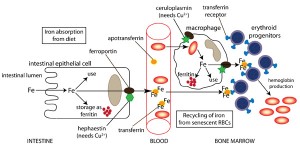Iron absorbed from the intestine is stored as ferritin in intestinal epithelium or transported in plasma as transferrin. Erythroid progenitors obtain iron for hemoglobin synthesis from plasma transferrin coming from the intestine or from recycling of senescent erythrocytes by macrophages in bone marrow, spleen and liver. Iron that is in excess for that required for hemoglobin production is stored in macrophages as ferritin. Excess iron is complexed to phosphate and hydroxide to form hemosiderin. These stores can be released from macrophages in times of need (increased erythropoiesis), with ferritin being more soluble and readily available compared to the insoluble hemosiderin.

